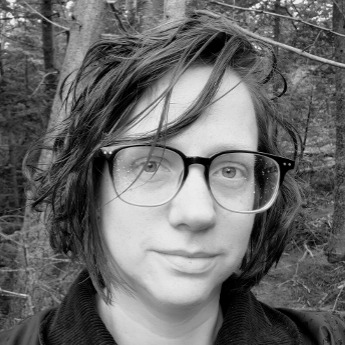 By Ashleigh Matthews
By Ashleigh Matthews
This is an excerpt from Ashleigh’s memoir Otherwise Grossly Unremarkable, which tells her story about finding a dense mass in her breast at only 35 years old which was eventually diagnosed as stage III, grade-three multifocal invasive mammary carcinoma. She lives with her husband and their two kids in Conception Bay South, Newfoundland and Labrador, and holds a BA in Cultural Anthropology from Memorial University of Newfoundland and Labrador. Ashleigh is also a textile artist and sewist. In addition to sharing her experiences with breast cancer, she cares deeply about the artist and maker communities around her, as well as the many friends she has met that share the experience of a cancer diagnosis. You can purchase Ashleigh’s book here.
The second of two ultrasounds that I underwent happened in early May. I waited for my name to be called while sitting in the same waiting area and then changed out of my clothing and into a hospital gown in the same locker room stalls that I’d occupied during my first ultrasound the previous December. The radiologist conducting my second breast ultrasound was not the same one who had carried out my first exam, and she began my appointment with the type of conversation a medical professional uses to help put a patient at ease when the appointment requires undressing.
“It’s nice to finally see some warmer weather,” she offered as I lay back on the examination bed.
“It certainly makes the walk from the car into the hospital easier,” I replied with a smile.
“This will feel a little cold now,” she explained as she squeezed the ultrasound gel onto the wand. She had the practiced ease of someone who has repeated this phrasing while carrying out this action countless times before. Next, she placed the wand on the top portion of the breast that had been at the root of my life hiccup for so many months.
“Huh,” it was as much a sound as a word that she uttered. There was no more friendly chatting about the weather or the temperature of the ultrasound gel now. I looked to the technician assisting the radiologist for her reaction, hoping it would contradict my own assessment of the radiologist’s change in demeanor upon seeing inside my body. Perhaps this is how she approached all of her diagnostic duties, and I was overthinking a normal display of diligence from this doctor because, after all, we’d never met before this appointment. The technician’s face, laser-focused on the radiologist, gave me no reason to relax. The radiologist’s body language was telling both the technician and me that something specific and unexpected was attracting her attention, and it had begun as soon as she put the ultrasound wand to the dense portion of my right breast.
The room shrunk and all that existed in the world was this radiologist and the screen she remained hyper-focused on. There was near silence in the room as she examined the dense breast tissue from every conceivable angle. Next, she went over and around my fully inverted nipple and through every conceivable angle, and over all the flesh of my breast under my nipple as well.
“I don’t like the density of this breast at all,” she finally revealed.
Samezies, I think, but am unable to force the quip past my lips.
“I want you in a mammogram machine for sharper images on these dense areas. It will also help us understand what’s going on behind your nipple.”
Did she say areas? As in, more than one?
“I’m referring you for a mammogram immediately,” she concluded with authority.
Gut punch.
Breathe.
“What’s the timeline like for getting in for a mammogram?” I asked. Quiet voice and dry mouth.
“I’m calling right now,” she replied as she turned from me to the telephone on the desk next to the ultrasound monitor and dialed a four-digit internal hospital number. Evidently “immediately” meant just that: immediately. Not simply the referral—the mammogram itself. I looked at the ultrasound technician on my other side as she put a hand on my arm and offered a strong smile.
I was simultaneously cold and sweating. I covered my chest with the flimsy cotton sides of the hospital gown. I didn’t know where to put my hands or what to look at as the call between the radiologist and her colleague continued. Should I ask for my clothing? Do I change out of this hospital gown, or is the mammogram happening in the same room, somehow? I was unable to comprehend the logistics of moving from one examination space to another when the movement was driven by such medical urgency that this next test could happen literally immediately. After a quiet and quick conversation, the phone was laid back in the cradle.
“She just finished up with the last appointment,” the radiologist told me. “The timing is perfect. She’s waiting for you now.”
Who is waiting for me? Where are they waiting? Questions that I, once again, could not put together into phonograms and phrases to ask this doctor who had just arranged
a mammogram for me with lightning speed.
“It’s okay,” the radiologist replied to my immobile silence, “let’s go. I’ll walk you to the mammogram room.” As she said this, she was already pulling my boots out from underneath the end of the ultrasound bed. She radiated patience as she waited for me to pull them on and then add a second hospital gown in reverse to cover my chest. As promised, the radiologist personally walked me down several corridors and into the room where the mammography technician was waiting for us.
The contrast between this experience—the response of this medical professional after seeing a diagnostic image of my breast versus the previous ultrasound that I had experienced—was more jarring than the mammogram itself. Add in the rapid transition
from ultrasound suite to mammogram machine and I barely had time to process the pancaking of my breasts between the mammography plates. While my body was in the mammogram machine, my mind, my emotions, my spirit, were focused on the forced neutrality of the radiologist’s face when she saw the inside of the density on the
ultrasound screen. A highly educated professional in the fields of both cancer and diagnostic imaging had seen something occurring inside my breast that she did not like, and she was not going to allow me to leave without more investigation.
“Could you place your arm up here and hold this handle, love,” asked the mammography technician, jolting my mind back into the environment occupied by my body. Hospital gown open, one breast squashed in a metal mammogram machine the height and colour of a tarnished C3PO.
“How quickly will these images be back?” I asked as she further adjusted my positioning with a gentle twist of my shoulders.
“It won’t take long, dear, a few days at most for them to be reviewed. I expect it’ll feel like an eternity for you, though.”
She stepped behind the protective radiation screen to capture more photos of the denseness, and I wondered if anyone had ever spoken truer words to me in my life.






